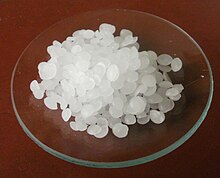
| |
| Identifiers | |
|---|---|
| ECHA InfoCard | 100.029.375 |
| UNII | |
| Properties | |
| CnH2n+2 | |
| Appearance | White solid[1] |
| Odor | Odorless |
| Boiling point | > 370 °C (698 °F) |
| ~1 mg/L[1] | |
| Hazards | |
| Flash point | 200–240 °C (392–464 °F; 473–513 K)[1] |
Except where otherwise noted, data are given for materials in their standard state (at 25 °C [77 °F], 100 kPa).
| |

Paraffin wax (or petroleum wax) is a soft colorless solid derived from petroleum, coal, or oil shale that consists of a mixture of hydrocarbon molecules containing between 20 and 40 carbon atoms. It is solid at room temperature and begins to melt above approximately 37 °C (99 °F),[2] and its boiling point is above 370 °C (698 °F).[2] Common applications for paraffin wax include lubrication, electrical insulation, and candles;[3] dyed paraffin wax can be made into crayons.
Un-dyed, unscented paraffin candles are odorless and bluish-white. Paraffin wax was first created by Carl Reichenbach in Germany in 1830 and marked a major advancement in candlemaking technology, as it burned more cleanly and reliably than tallow candles and was cheaper to produce.[4]
In chemistry, paraffin is used synonymously with alkane, indicating hydrocarbons with the general formula CnH2n+2. The name is derived from Latin parum ("very little") + affinis, meaning "lacking affinity" or "lacking reactivity", referring to paraffin's unreactive nature.[5]
- ^ a b c Record in the GESTIS Substance Database of the Institute for Occupational Safety and Health
- ^ a b Freund, Mihály; Mózes, Gyula (1982). Paraffin products: properties, technologies, applications. Translated by Jakab, E. Amsterdam, the Netherlands: Elsevier. p. 121. ISBN 978-0-444-99712-8.
- ^ Raw materials and candles production processes Archived 21 March 2020 at the Wayback Machine, AECM
- ^ "History of Candles". National Candle Association. Retrieved 25 February 2016.
- ^ "Paraffin, n". Oxford English Dictionary. Oxford, England: Oxford University Press. March 2009.